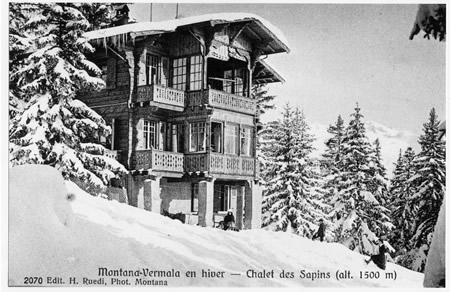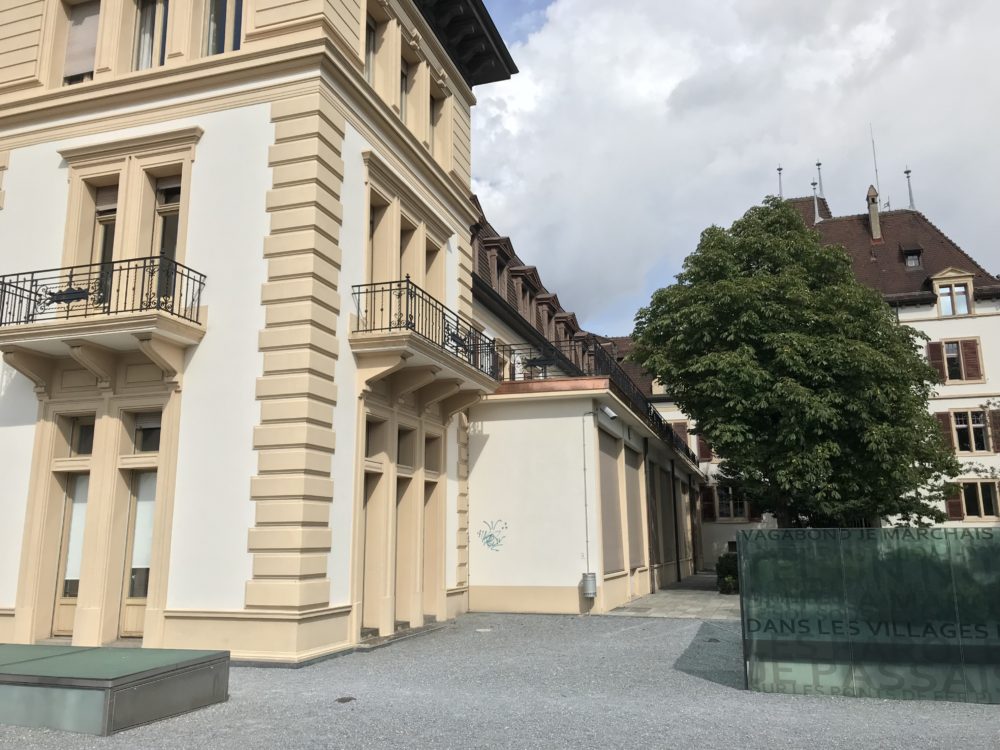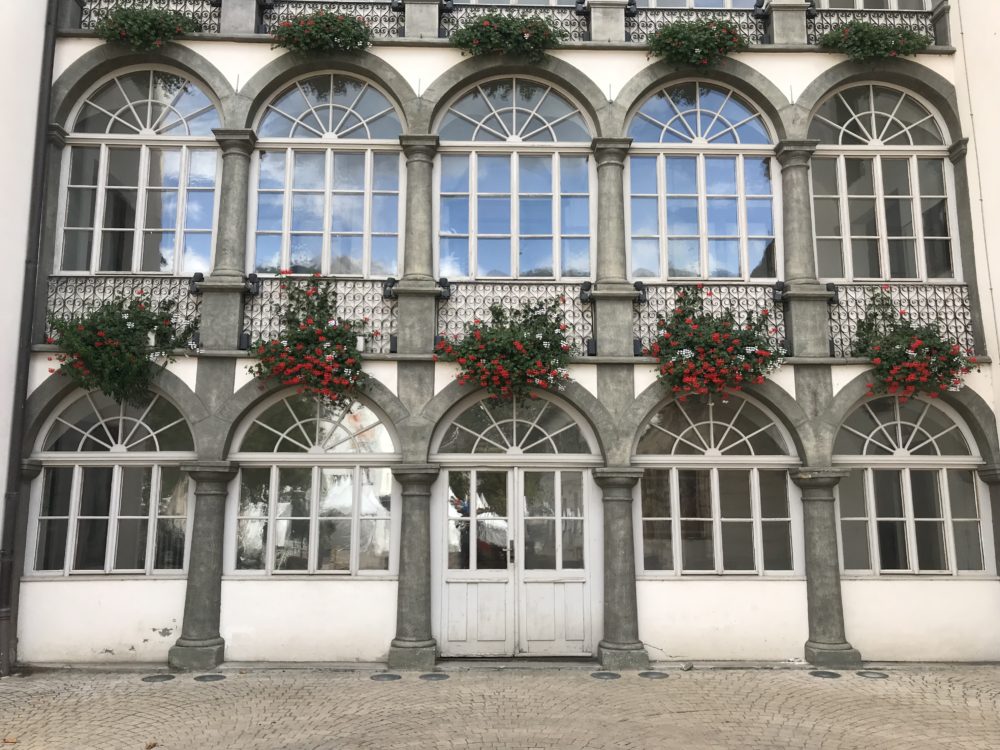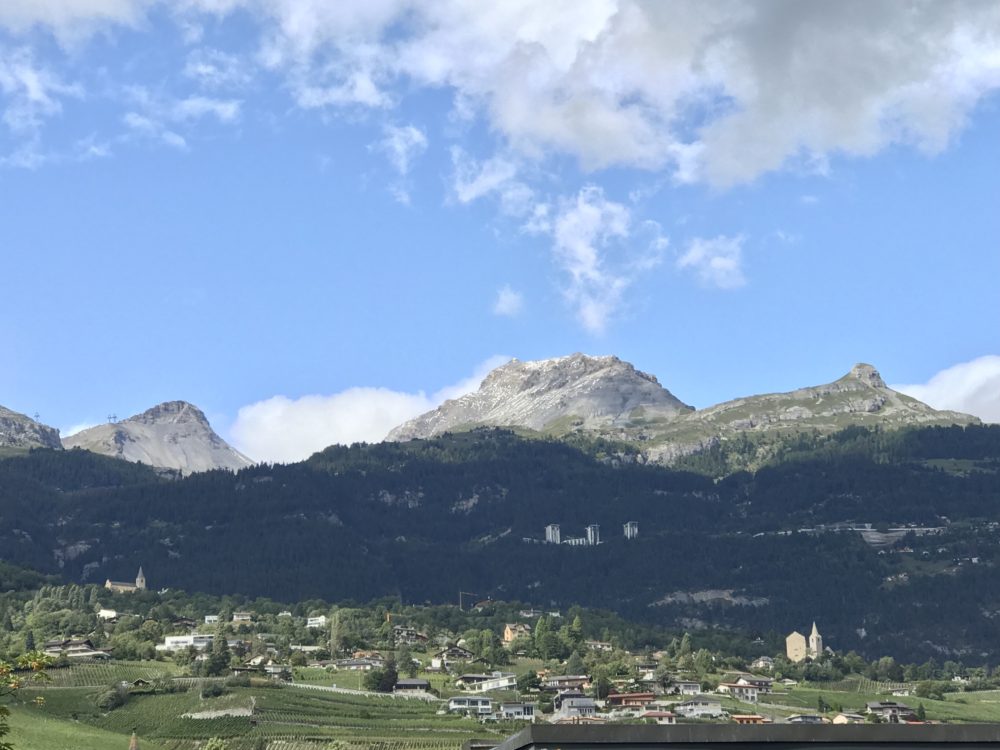
The New Zealand short story writer Katherine Mansfield spent seven months in Montana, Switzerland, in 1921, seeking to escape the heat of the south of France and undergoing the fresh air treatment for tuberculosis for which Montana had become famous. In a letter from Menton to the painter Dorothy Brett, Mansfield wrote: “All our flags are pinned on Switzerland. Meadows, trees, mountings [sic], and kind air. I hope we shall get there in time …” Mansfield was beginning to be aware that time was running out for her even as she tried to imagine a more long-term future. Responding to her plan to take a chalet above Sierre, her husband, John Middleton Murry, wrote back: “I simply long to spend a year – two years – a lifetime of years with you at Sierre. It sounds & looks divine. I know I shall be terribly happy there. I’m all for a little chalet.”

Chalet des Sapins, Montana.
The English doctor who attended Mansfield in Montana suggested that she rent the Chalet des Sapins, belonging to his mother. Nestled in a forest of pine trees, it was where the writer had her last sustained period of creativity, during the summer and autumn of 1921. Here she wrote a suite of stories, republished as The Montana Stories, which have assured her posterity. Jennifer Walker, in Elizabeth of the German Garden: A Literary Journey, describes the setting:
It was comfortably furnished and arranged on three storeys. Katherine wanted to occupy the top storey so that she could see over the treetops, down across the valley and look at the views of the mountains all around. During the daytime, the birds came and perched on her balcony and took breadcrumbs. At night, the clear moonshine would stream in through the window. She found that her soul was at peace in this place; she could begin again to write. Despite relapses and constant fatigue, the next seven months were the most productive of her life.

Part of the gardens at the back of the Hotel Bellvue, Sierre
She spent her days in Montana on the large balcony adjoining her room, admiring the view she was too invalid to explore, and writing stories set for the most part in her native New Zealand. She had been brought up with the help of servants and an allowance from Daddy, supplemented by handouts. A measure of independence from family had given her the habits of the inveterate hippy: inviting herself to country houses, using friends and acquaintances as means, for favours, treating her school friend, Ida, as a lady’s maid. She was nineteen before she learned to peel potatoes. The Swiss woman hired to do the peeling in Montana was called Ernestine, a name given to a character in one of the writer’s last stories. Mansfield’s husband had lecturing and editing commitments in London and their decade-long relationship, often fraught and dependent, was under strain. By June 1921, Ida Baker, always on hand to fill the gap, moved into lodgings in the village when Murry was in residence. It was a curious though working set of relationships at the chalet:
They read and wrote, sitting on their balconies as birds flew past, bright pots of flowers beside them and the forest and mountains all around. Katherine wrote to Brett that they had no intention of returning to England for years; here were woods and streams and the sound of bells in the air, golden sunshine with only occasional days of white mist, nights of planning future travel and future homes.
Mansfield had been drawn to free love, and styled herself a “New Woman” with “advanced views”, without quite joining the ranks of the suffragettes. She was what the writer Hermione Lee describes as “sexually reckless and socially excitable”. As the war advanced, however, declining health had taken the shine off Mansfield’s recklessness.

… built for Elizabeth von Arnim. Only her writing chalet, lower right, still exists.
Mansfield’s cousin and a writer of renown, Elizabeth of the German Garden, had a splendid chalet nearby at Bluche-Randogne. She climbed the hill every couple of days or so, to visit her cousin, bearing bunches of flowers and the fruits of the summer to Mansfield’s door:
We exchange Chateaubriand and baskets of apricots and have occasionally lovely talks which are rather like what talks in the after-life will be like, I imagine … ruminative, and reminiscent – although dear know what it is really all about.
The things of life were slipping out of Mansfield’s reach, as they have now slipped from living memory, and she fixed them in her stories: high tea with sardines, the primus stove, antimacassars, photos behind tissue paper, poor girls’ clothes stitched from rich girls’ cast-offs. In Mansfield’s late stories, collected in The Garden Party (1922), and written for the most part in Montana, there is a strong sense of an ending: “Life! How many there were! There were three dozzing at least. And she held hers up to the light.” By August 1921 Mansfield was writing the short story “At the Bay”. It follows the inhabitants of a row of beach bungalows over the course of twenty-four hours, borrowing the modernist device of squeezing human life into a day’s progress. Mansfield summed up her masterwork as:
full of sand and seaweed, bathing dresses hanging over verandas, and sandshoes on window sills, and little pink ‘sea’ convolvulus, and rather gritty sandwiches and the tide coming in. And it smells (oh, I do hope it smells) a little fishy.
She had read, reread and liked James Joyce’s A Portrait of the Artist as a Young Man (1916) and parts of Ulysses (1922) that had appeared in The Little Review, and was able to get past what others, particularly in the Bloomsbury set, thought of as Joyce’s vulgarity. When Mary (Elizabeth of the German Garden) returned from London in the new year, Mansfield and Murry were still in residence at the Chalet des Sapins. Mansfield’s moods could be volatile, her marriage was riven with resentments and in her desperation for a cure she was beginning to consider occult treatment in Paris. Mary visited, bearing gifts, and praised Mansfield’s “At the Bay” which had appeared in the interim in the London Mercury, describing it as “a pretty little story”.

Bellevue Hotel, Sierre, with the vines in the garden clearly visible, and the adjoining English chapel.
After a stay at the Hotel d’Angleterre in Montana, suffering from pleurisy, Mansfield with Ida in tow this time, settled into the Hôtel-Château Bellevue in Sierre. The lease on the Chalet des Sapins had run out. No doubt it was fumigated. Murry stayed up in Randogne, coming down to visit them at weekends and to play billiards in the hotel. Mansfield recalled learning to play at the Prime Minister of New Zealand’s residence. It was a hot summer and the hotel was cool and well appointed, in a building dating back to the 17th century. At the time of the Grand Tour, an English chapel had adjoined it, as was the case in a number of Swiss resorts at the time. Mansfield’s room was towards the back, facing the sloping vineyards and the train tracks that led across the Simplon and south into Italy.

The former Hotel Bellevue in Sierre, now the Hotel de Ville.
But that enchanted hotel was more exquisite than ever. The people so kind and gentle, the waving branches outside the windows, a smell of roses and lime blossom. After a very powerful wash and an immaculate lunch – how do the glasses and spoons shine so? – I lay down and went to sleep and Jack went out.
In late July she wrote her only short story with an identifiable Swiss background, “Father and the Girls’, perhaps anticipating the visit of her father and two sisters whom she would meet for the final time in London at the end of summer. Father is frail and elderly and the two girls are his minders, on a European tour that seems to be running out of steam:
Now a wisp of white smoke shone and melted. Now there was another, and the monster itself came into sight and snorting horribly drew up at a little, toy-like station five minutes away. The railway ran at the bottom of the hotel garden which was perched high and surrounded by a stone wall. Steps cut in the stone led to the terraces where the vines were planted.

The view across the tracks from the back of the former Hotel Bellevue in Sierre.
Mansfield begins the story with a character named Ernestine, no doubt in homage to Ernestine Rey who had cooked for her and Murry up at the chalet. Daughter Edith looks out the hotel room window and sees “a whole, tiny landscape bright as a jewel in the summer heat.” It was the Valais, with the Weisshorn and the Matterhorn in the distance. The three characters seem to flit through the interior of the hotel like ghosts, revenants, insubstantial. They haunt the shadowy interior rather than being out in the sun. They abjure a five minute walk for a carriage ride from the station. The daughters “had reached the age when it is as natural to avoid mirrors as it is to peer into them when one is young…”.

The view north to Montana from Sierre.
Shortly after abandoning this story, Mansfield wrote her will, faced the prospect of an irreparable split in her marriage and must have known that her Swiss interlude had come to a close. She glanced at the mountains that had made her illness more bearable and where she had written her best work. “Have you noticed how very smug those mountains look that are covered with snow all the year round. They seem to expect me to be so full of admiring awe.”
All trace of Chalet des Sapins, where Katherine Mansfield had written and enjoyed the mountain air, has been obliterated by the Hotel Helvetia Intergolf. The village perched facing the sun has grown into one of Switzerland’s wealthiest and most fashionable resorts. “How hard it is to escape from places,” Mansfield wrote. “However carefully one goes they hold you – you leave little bits of yourself fluttering on the fences.”

